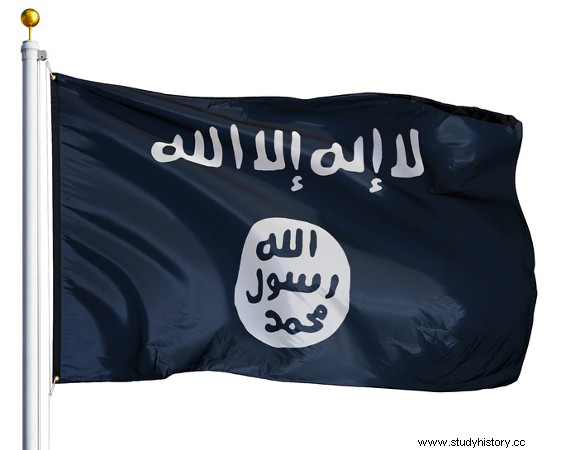
On August 29, 2014, the Sunni terrorist group Islamic State (IS) – which was once also known as Islamic State in Iraq and Syria (EIIS) and Islamic State in Iraq and the Levant (ISIL) – announced that its leader, Abu Bakr al-Baghdadi , self-proclaimed caliph of the northwestern region of Iraq and part of central Syria.
The title of caliph was given to the former successors of Muhammad, who had legitimate political authority by the Islamic religion. The Islamic State has since been widely covered by the Western media, mainly because of its extreme actions against the civilian population of Syria and Iraq, such as the rapes and massacres of Christians, Shias and other religious and ethnic minorities. Furthermore, this group is behind a series of terrorist attacks in Europe and other parts of the world. One of the most recent attacks took place in the English city of Manchester on May 22, 2017, with 22 dead.
Origins of the Islamic State
The history of the Islamic State terrorist group is related to the process of political crisis that unleashed in Iraq after the war started in 2003. The Iraq War took place two years after the terrorist attacks of September 11, 2001, led by members of the Al-Qaeda organization, then led by Osama Bin Laden . Al-Qaeda had a large operating space in Iraqi territory and in part of Syria.
The Islamic State group was born as an offshoot of Al-Qaeda (the two groups broke off relations in February 2014) and is based on the same principles of that organization, which go back to the pan- -Islamic of Sayyid Qutb, former leader of the Muslim Brotherhood. However, in addition to the influence of Sayyid Qutb's fundamentalism, IS has its ideological roots related to Wahabism .
The Wahhabi movement emerged in Saudi Arabia in the 18th century from the preaching of Muhammad ibn 'Abd al-Wahhab and advocated the Islamic "purification of the faith" with the return of Islamic practices of the seventh century. The main point of Wahhabi ideology is the literal interpretation of the precepts of the Koran. Today Wahhabism is the ideological root for most of the existing Islamic fundamentalist groups.
Aims and targets of the Islamic State
The main objective of the Islamic State is to expand its caliphate throughout the Middle East, which would be guided by the sharia , Islamic Law interpreted from the Koran. In addition, IS seeks to establish connections in Europe and other regions of the world, with the aim of carrying out attacks that can give it authority through terror.
The conception of Jihad , or Holy War for Islam, that IS has is the same as other terrorist organizations such as Al-Qaeda or Boko Haram:expanding the radical Islamic theocratic model of government around the world through terrorist methods, especially against civilian targets .
It is curious that non-Islamic sympathizers, and often of European origin, support the IS causes. Many young people from the West volunteered to join the group and serve its jihadist purpose. Recently, the case that drew the most attention was the accession of many young people born on the Caribbean island of Trinidad and Tobago to IS.
This type of behavior worries many heads of state around the world, especially because of the possibility of infiltration that these young people, trained as terrorists, can carry out in different parts of the world, mainly in Europe . The adhesion of a large number of young people may be related to their marginalization in society, combined with the alienation they are subject to in contact with fundamentalist ideologies present in some Islamic communities.
Domination and weakening of the Islamic State
The Islamic State came to dominate large and important Iraqi cities, such as Mosul, Tal Afar, Kirkuk and Tikrit. A large contingent of the population migrated from these cities to neighboring towns or villages, fleeing the brutal expansion of the Islamic State. However, some of these cities were retaken by the Iraqi army or other paramilitary militias. Below is the status of each of these cities currently:
-
Mosul :attacked by Iraqi forces. ISIS has lost control over most of the city, but it still concentrates resistance in an area of Mosul. The group's resistance may be about to be defeated;
-
Such Afar :dominated by IS;
-
Kirkuk :controlled by the Kurds since March 2017;
-
Tikrit :controlled by a Shiite paramilitary group known as the Khazali Network.
ISIS is currently estimated to have lost around 14% of the territory it controlled at the end of 2015. Both Iraqi and Syrian forces and other militias have gradually reclaimed territories of that group. In addition, there is foreign action in the fight against IS, such as the US-led coalition, which, since 2014, has conducted more than 11,000 airstrikes against the group in Iraq and more than 9,000 airstrikes in Syria| 1| .
The weakening of the Islamic State has also affected its funding. ISIS is believed to have been impoverished compared to 2014 and 2015, however, the budget of this terrorist group is still over two billion dollars, obtained mainly from the sale of oil|2| .
|1| Islamic State and the crisis in Iraq and Syria in maps [Text in english]. To access click here.
|2| Ditto, link above.
